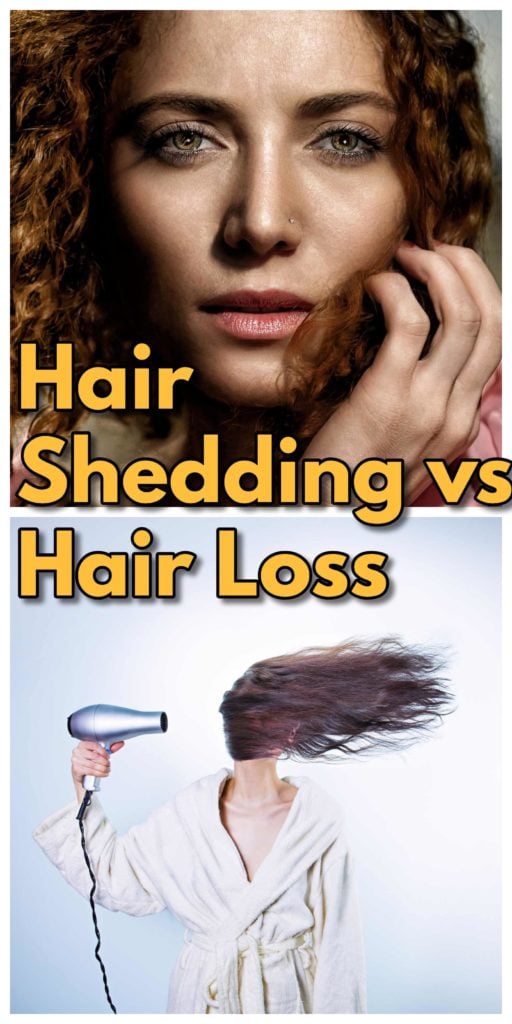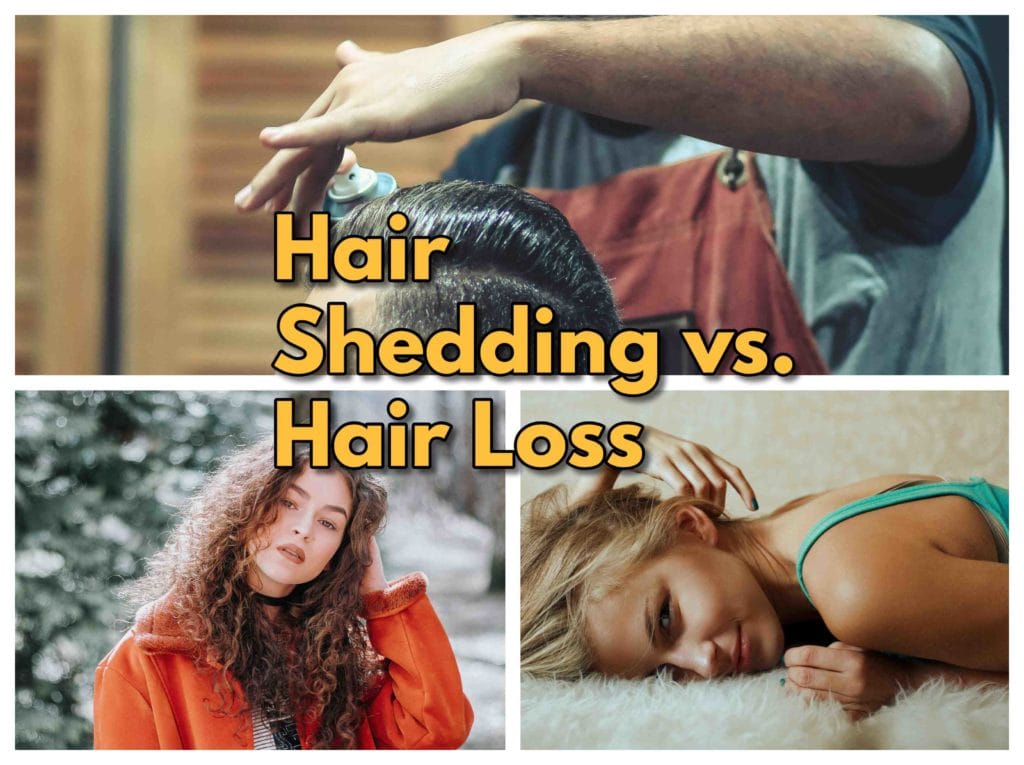Have you been experiencing a lot of hair loss recently? The American Academy of Dermatology suggests that, to the greatest extent possible, one should remove individual strands of hair daily to minimize the risk of experiencing hair loss.
Nevertheless, one potential contributor to hair loss is the loss of hair itself. In contrast to normal hair shedding, hair loss is a severe condition that requires immediate medical attention. This in-depth article will assist the reader in differentiating between the various patterns of hair growth.
The hair growth cycle
It can help you understand how hair loss develops and provide information on how to prevent it. The life cycle is divided into three parts: the anagen, categnostic, and telogen stages, which respectively represent growth, transition, and death.
Most folks lose 100 hairs daily. Consistent hair loss causes concern. In the telogen phase, hair sheds.
New hair grows in its place, and the process begins once more. During one year, approximately 90 percent of hair follicles will be in a growing phase, while just 9 percent will be in the telogen phase (shedding).
New hair growth originates in the dermis’s hair bulb. About 1.3 cm of new hair grows each month. After stopping growth, hair enters catagen.e catagen phase.
The catagen hair then becomes a telogen hair, and the hair shaft bends (also called club hair). The freshly growing hair pushes out the telogen hair after two to three months.
The phases of the hair growth cycle vary for different body hair types. Fibroblast growth factor may determine anagen phases and hair size.

Your hair has its own natural cycle
Have you ever counted the number of hairs on your head? It should be possible for each hair to survive for four to five years. I guess you could say that it’s adequate.
There have been reports of people losing their hair. People typically lose between 60 and 50 hairs daily because hair follicles go through their entire life cycle. However, it seems to be quite extensive. If you compare this number to the length of your 100,000 hairs, you’ll see that it’s not quite as impressive.
What is hair shedding?
During the human hair growth cycle, normal hair shedding of hair occurs. As mentioned, the average person loses between 50 and 100 hairs daily. It may seem significant, but the average person loses roughly 100 hairs every time they shampoo.
However, this number is relative. Keep in mind that a human head includes 100,000 individual hairs. During the exogenous stage of growth in the follicles, the process of hair shedding takes place.
The exogen phase comes after telogen rest phase and is when a human body starts to form its hair follicular cells in order to begin a new growth of the rest phase. In spite of the fact that the telogen phase lasts for a full three weeks, the exogen phase is the one that lasts the longest during the entire hair growth cycle.
Hair shedding is the body’s natural cycle of renewal; when some hairs fall out, others replace them. When the equilibrium is broken, more hair falls out than grows in, causing hair loss.
The difference between hair losing and shedding?
When mainly on our hairline, you should focus on the crown and the hairline. Pay attention to both of these areas. There is a recognizable progression for males. It’s possible that this is a sign that you’ve started losing your air before you noticed the bald spots, or that your hairline is moving further away from your head.
Normal hair shedding is described above, which occurs all by itself; hair loss is almost always triggered outside the body. Loss of hair happens when anything thwarts the normal growth of hair on the scalp.
In medical terms, this condition of hair loss occurs due to the type of hair loss that occurs due to something that prevents the hair follicle from splitting or producing energy. Although it is possible to stop hair loss, it can take anywhere from one three months for new hair to start growing in. In the most extreme circumstances, it might potentially lead to permaYou may suffer.
It is possible that you are suffering hair loss if you notice that your hair is becoming thinner or if you shed more than the typical 100 strands of hair each day. It might be difficult to distinguish between hair loss and hair shedding, but you should see a dermatologist if you notice an increase in the number of hair strands licensed dermatologist is on your comb or pillow. Remember that a licensed dermatologist is the best person to determine hair shedding.
Causes of hair loss
Losing one’s hair can be an upsetting experience and can impact people of any age, from children to elderly. Hair loss can be attributed to one or more of the following factors:
- The past of the family (her The inherited issue manifests itself as normal aging is the most common reason for hair loss. Androgenic alopecia, also known as male-pattern baldness and female-pattern baldness, is the name given to this disorder. In most cases, it happens gradually and follows a pattern that may be anticipated, such a receding hairline and bald spots in men, and thinning hair along the crown of the head in women.
- The deficiency of various nutrients in your body can cause hair fall. Lack of iron, thyroid, zinc, and other nutrients, as well as other factors, might contribute to excessive hair shedding.
- Thyroid Conditions. Hair loss on the scalp can be a symptom of thyroid disorders that cause your thyroid gland to generate too many (hyperthyroidism) or too little (hypothyroidism) of particular thyroid hormones that aid in regulating your metabolism.
- Dihydrotestosterone (DHT) causes hair loss. DHT is gener and also from testosterone by 5-alpha reductase. They are also created from DHEA, a female hormone. DHT is present in the skin, hair, and prostate. Hair loss is caused by DHT and hair follicle sensitivity. DHT has a prostatic effect. The prostate doesn’t develop without DHT. With too much DHT, a guy can get an enlarged prostate.
- Medicines and nutritional supplements. Certain medications, including those prescribed for treating cancer, arthritis, depression, heart disease, gout, and high blood pressure, can cause hair with unwanted side effects.
- Treatment involving radiation to the head. It’s possible that the hair won’t go in the same way it did before.
- An really distressing occurrence. When the body has experienced stress, excess hair shedding frequently happens and is commonly detected three months after the trigger event.. The hair loss associated with this condition is only transient.
- Coiffures and various treatments for alopecia are a form of hair loss that can be caused by over-styling your hair or wearing hairstyles that pull your hair tightly, such as pigtails or cornrows. In addition, hair thinning can be brought on by permaIf treatments for the hair.
- Another most common cause is harsh hair care products or a compulsion to pull out your own hair
Managing excessive hair shedding vs hair loss
You don’t have to suffer in silence if you’re concerned about the amount of hair falling. You can seek advice from a dermatologist. Besides that, the other best techniques include:
Scientific nutrition
To maintain healthy hair, you should eat nutritious proteins including: lean meats, fish, beans, low-fat dairy
A study indicated that adequate intake of the following nutrients was linked to good hair growth: Vitamin D, Vitamin C, iron (especially in women)
Stress-reduction
There are stress-related hair-loss diseases. Yoga, meditation, breathing methods, therapy, and avoiding daily stressors can help you de-stress, which can have various health benefits.
Haircare
Healthy hair begins with shampoo. Choose products for your hair type that are exemplary. It’s oily, dry, fine, or color-treated. Gentle hair care promotes healthy growth. Using shampoo and towel softly. Wet hair is more fragile.
Other treatment options
- Laser treatment
- Surgical hair, some studies show are studies that show that the right amount of DHT helps revers hair loss. So, drug inhibiting the 5-alpha reductase enzyme that converts testosterone to DHT
- Treatment for thyroid problems: Hypothyroidism drugs include Natural Desiccated Thyroid or Desiccated Thyroid Extracts such as Real Thyroid and VitaliThy type of Natural Desiccated Thyroid you can buy online. Levothyroxine is another medication.
Hair shedding after covid
Your body will be thrown into shock as a result of the stressors that COVID creates, which will disrupt the growth-rest cycle. Several months after becoming infected with COVID, the outcome is accelerated hair loss, with as much as 30 to 50 percent of hair follicles being in the telogen stage, compared to 5 to 10 percent. This occurs because more hair follicles are in the telogen stage.
FAQS
Does shedding hair mean balding?
Although the amount may appear large, you observe normal hair loss. Baldness often refers to a significant loss of scalp hair. The most frequent cause of baldness with aging is hereditary hair loss.
Do hairs grow back after shedding?
When someone is shedding hair, a lot of hair might fall out. The good news is that when your body acclimates, the excessive shedding slows (usually without any medical treatment). When your body has had time to react to the initial stressor or source of shedding, the excessive shedding ought to stop.
Why am I experiencing excessive hair shedding more than usual?
Telogen effluvium, or excessive hair shedding, is not a genetic result; it results from an internal imbalance or upheaval, such as a nutritional deficiency, crash dieting, or an illness. People with significant stress levels are also more likely to experience excessive hair shedding.
How do I know if I’m suffering excessive hair shedding?
A person’s typical daily hair loss is between 30 and 50 strands. Stress is one such element that can occasionally lead to significant hair thinning. You lose more than 100 strands every day in this situation.
Is there a way to reduce hair shedding?
Yes, besides the treatments mentioned above, it is important to remember that to decrease hair shedding, you need to maintain a healthy hormonal balance, especially regarding your thyroid hormones.
